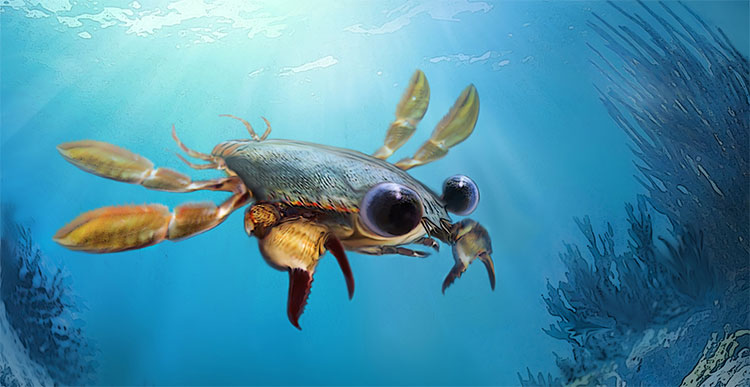Scientists Discover a New Crab Species from 90 Million Years Ago with Stunning Appearance, Featuring Bright Colors Like Characters from a Pixar Animation.
In the modern animal kingdom, crabs are not known for their good eyesight or strong swimming abilities. They typically move along the ocean floor, feeding on smaller creatures such as seaweed, algae, crustaceans, or carrion.
However, 90 million years ago, during the Cretaceous period, there existed a species of crab in what is now the offshore waters of Colombia, boasting impressive predatory skills. Although it was only tiny (2.5 cm), Callichimaera perplexa resembled a spider more than a crab, with paddle-like flattened limbs that allowed it to swim faster in the water. It looks very different from its modern relatives today.
Notably, the eyes of Callichimaera are unusually large compared to its body size, a stark contrast to modern crustaceans.

Callichimaera Perplexa crab from 90 million years ago is stunningly beautiful.
Callichimaera Perplexa – its name refers to a hybrid creature in Greek mythology, comprising body parts from various animals.
The Callichimaera Perplexa crab has a colorful appearance reminiscent of cartoon characters. Its flattened paddle-like legs and large eyes are particularly intriguing.
In a study published last month in the journal iScience, a team of paleontologists noted that these large eyes provided Callichimaera with sharp vision, enabling it to function as a predatory animal.
The first fossil of this species was discovered in 2005 by Javier Luque, a paleontologist from Colombia who is currently conducting research at Harvard University. At that time, Luque was still a student participating in excavations in the Boyaca region of Colombia, which is rich in fossils of ancient animals.
Dr. Javier Luque, a paleontologist at Yale University and the University of Alberta, described this crustacean as very “cute” but also very “unusual.” Luque stated, “It provides us with information about how new forms of life can evolve over time.”
Luque and his colleagues discovered the Callichimaera Perplexa fossil in 2005 in the mountains of Pesca, Colombia.

Callichimaera fossil discovered in 2005 in Colombia. (Photo: New York Times).
Dating back, the Callichimaera Perplexa lived during the mid Cretaceous period, when dinosaurs ruled the earth. Based on the location where the fossil was found, scientists predict it lived in areas such as Colombia, North Africa, and the state of Utah (USA).
Crabs undergo several developmental stages, starting their life cycle as small mollusk-like creatures before transforming into armored animals. In the final larval stage, known scientifically as megalopa, juvenile crabs have relatively large eyes and swim freely to hunt smaller prey.
When Luque and his colleagues described the fossil of Callichimaera, they suggested it might be a crab in the megalopa stage, and that it would grow much larger as it matured.
“If you have eyes this big, you must definitely use them for something, especially since no other crabs look like this,” remarked Kelsey Jenkins, a paleontologist at Yale University and a co-author of the study.
The two scientists concluded that Callichimaera used its eyes, which were about 16% of its body size, combined with paddle-like limbs as a way to effectively observe and hunt prey.
Thus, instead of transforming into a more “docile” state like modern crabs, Callichimaera retained its shape from the final larval stage into adulthood. They are active predators, unlike the crabs we see today.
Remarkably, the vibrant appearance of Callichimaera Perplexa has astonished scientists. Researcher Luque even stated that if this creature existed today, it would surely become a famous “actor” throughout Hollywood.


















































